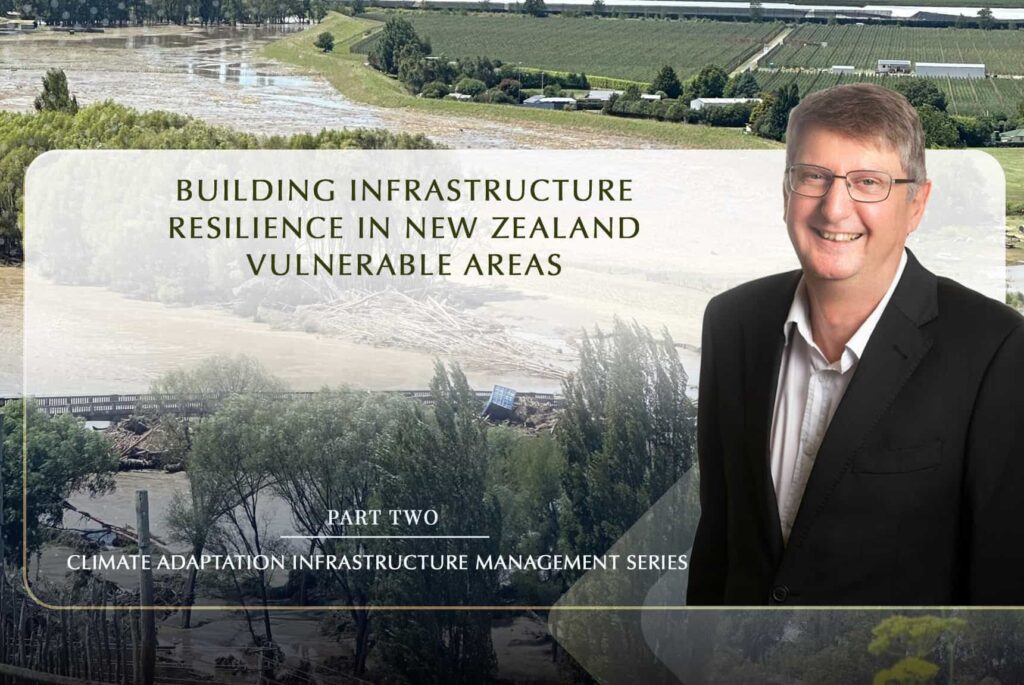Climate Adaptation Infrastructure Management Series Part 2

This is the second part of Ross Waugh‘s Climate Adaptation Infrastructure Management series.
Here, he answers how New Zealand can build infrastructure resilience, on the increasing frequency and severity of climate events, how locals can be better prepared to cope, and when it is time to move out.
How can New Zealand improve its critical infrastructure to withstand the annual heavy rains and floods better?
Every year New Zealand experience heavy rains and floods across the country, for example, Nelson -Tasman in August 2022, Buller, Nelson, and Marlborough in July 2021, Ashburton flooding in 2021, Marlborough Region in July 2021, and many others. The latest is Auckland’s unprecedented flooding on January 27 and Cyclone Gabrielle just two weeks after in mid-February this year). Given the magnitude of destruction from these recent events, how can we make our infrastructure more resilient, especially our critical infrastructure like roads, airports, stormwater, and wastewater infrastructure?
Ross:
Flooding is not a new thing in New Zealand. Even in South Canterbury, where I live, there was a massive flood in 1986 and Invercargill in 1984. The question about frequency is a serious issue, and the same applies to the Pacific region where there are cyclones and typhoons, how often they occur, and how big.
Our past records do not tell us. Māori oral records, for example, go back a millennium, but we haven’t been good at talking with them and finding out about this information.
If you have a community that has lived along the rivers or the sea for a thousand years, you will know when the significant events happened. There will be stories and histories of that.
So, there is a knowledge base there that has not been recognised and tapped into. But these long records will not help you when you’ve got rapid climate change, and the magnitude and impacts of those changes are evolving.
As I’ve mentioned earlier, we need to have more considerable safety factors; that is how you deal with uncertainties. This also means leaving unsafe areas to settle in, moving to higher grounds, and not living right along the rivers.
How can vulnerable areas cope with climate change impacts?
Regarding the vulnerable areas – coastal and low-lying areas, what should residents be thinking of doing to be in a better position to cope with climate change impacts?
Ross:
Flooding and earthquakes are two of New Zealand’s most likely events. We know that Civil Defence Emergency Management work involves teaching children in school how to react during earthquakes. They teach things like drop, cover, hold, get under something to protect yourself from falling objects, and not run in the street because something might be falling. These are the things taught here in New Zealand to kids from a very young age.
We are also taught about having family safety plans. Still, not everybody follows this, so this is your first problem, even though there is widespread education on the earthquake issue in New Zealand.
Another thing that has happened in the last decade is the tsunami safety zones. Here in Timaru, we have Caroline Bay. Some guidance and signage say you’ve got to get up the hill in case of earthquakes and tsunamis. And this is the same in Wellington. We’ve done all this stuff, but there are problems – not everybody engages with it.
This is the same response in people living in flood-prone areas. We need to identify the vulnerabilities, plan for early warnings, and get people out before the flood happens; these are the initial things.
The issue always, especially when you talk with officials or anyone involved with the Civil Defence Management, is they would point out that the problems lie with the people who did not engage with the planning for whatever reason like language, socio-economic difficulties, or whatever it is but you cannot just abandon them. They will also need a plan that can start with lots of education and evacuation based on good information before people get clobbered by an event.
This also includes migrants for whom English is not their first language. They do not grow up here, so they might not be aware of the risks. The same goes for New Zealanders when we are overseas. We also do not know all the risks.
For example, we can’t always tell the difference between a poisonous and non-poisonous snake because we don’t have snakes in New Zealand and have limited knowledge of them, so what you do not know is what will always trip you up.
Education, communication, and working with various groups and communities are essential to get the message out. And stuff is constantly changing, so the things we previously knew might not be correct anymore.
How can New Zealand manage relocations?
When necessary, how can locals be persuaded to relocate elsewhere? And who should pay for their relocations?
Ross:
One of the things that are going to happen – and it is already starting to happen. You see, New Zealanders are a reasonably highly insured country despite our wide range of geographical and natural hazards and risks. Part of the reason for that is what is called a socialised system to base insurance risks through the Earthquake Commission (EQC).
When the Christchurch earthquakes came along, the funds that were held for that around $6 billion were all expended in the Christchurch and Kaikoura earthquakes. The government looked at collecting a special tax or increasing the levies for EQC, and that’s what they did – they tripled the earthquake levies, which has built up the fund more rapidly to cover future risks.
Obviously, some thinking has gone on since Christchurch as to what the size of that fund needs to be, so that was a decade ago now. In terms of relocation, for argument’s sake, you took the worst-case scenario, where the house is on the river and on the coast, where it’s getting hit by sea level rise or river flooding. At some stage, the insurance company, after the first, second, third, and fourth time, will say, look, this is not an insurable risk.
When you can’t get insurance, you can’t borrow money, so it sort of takes care of itself in that regard. However, that’s a worst-case scenario, and people get caught up in that.
So, you have got this issue where you need legislation and public policy to define the rules, which is still in process in New Zealand at the moment. You need a whole country discussion around insurance mutualisation.
Are we going to extend EQC for flooding, and how much? How much risk will be covered before you have to insure it yourself?
You will then make your case to the national and international reinsurers on how that risk is managed because they also need to have a business still and manage their risks.
There are a couple of towns up on the east coast of North Island where they might end up in a situation where it is impossible to save their homes, which can lead to a staged relocation.
Again relating to our previous discussion, it is extremely difficult when this happens to be a marae or Māori land and in places where their family has lived over a thousand years, including burial grounds. I think where we end up is staged relocation, but there needs to be a lot of discussions and consultation again.
And maybe one of the public policy responses is to have a national insurance cover held for these things that everybody pays into one way or another that is slightly different from EQC.
So there’s quite a lot of policy response that could develop, but there is a process that takes a lot of discussions.
The good news is New Zealand has a long and broad experience in insurance coverage and managing national disasters. We are a very geologically active country. We get a lot of earthquakes, volcanic activity, landslips, flooding, etc.
We also got a significant pool of high levels of expertise and research around such things, so there is an answer that can be developed. It’s just a matter of speeding up the process and scaling it up, including the legislative frameworks, to catch up with what we need to do.

About the Author
Ross Waugh is the founder and director of Waugh Infrastructure Management. He is an asset management and systems integrations specialist with over three decades of experience.
His company provides infrastructure asset management consulting in transportation, utilities, community facilities, parks, and properties in New Zealand and overseas.
He also co-leads the Climate Adaptation Platform, designed as a portal for recent, relevant information to support governments and councils to help them adapt and be resilient to climate change effects.


Leave a Reply